DEEPA BHARATH
Thu, November 9, 2023
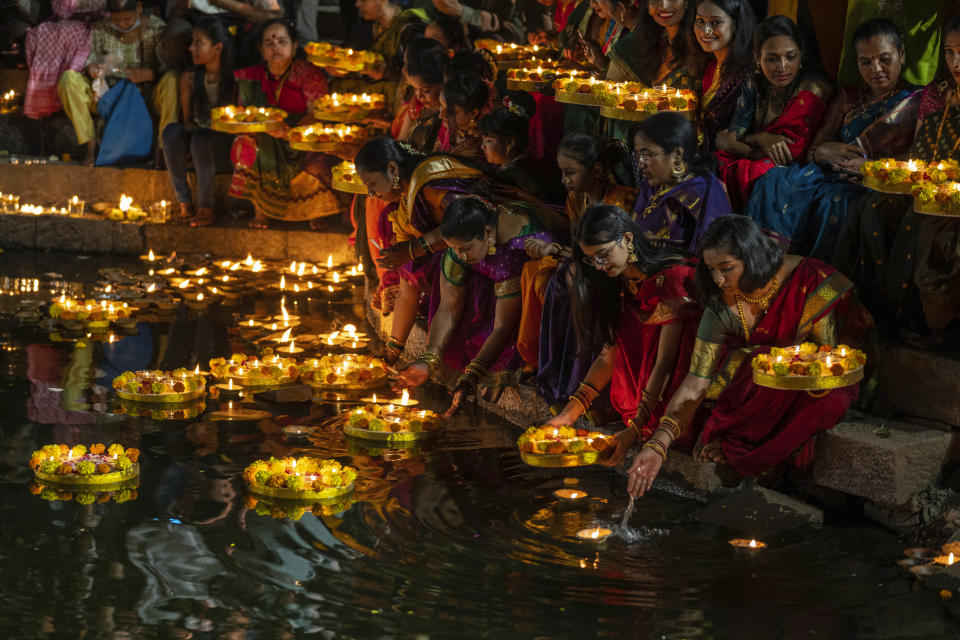
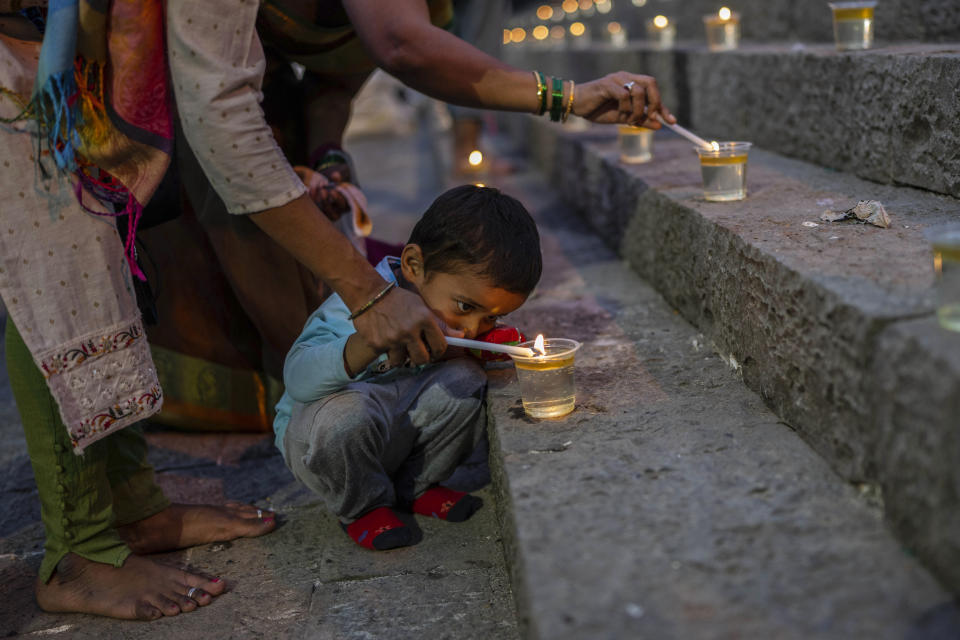
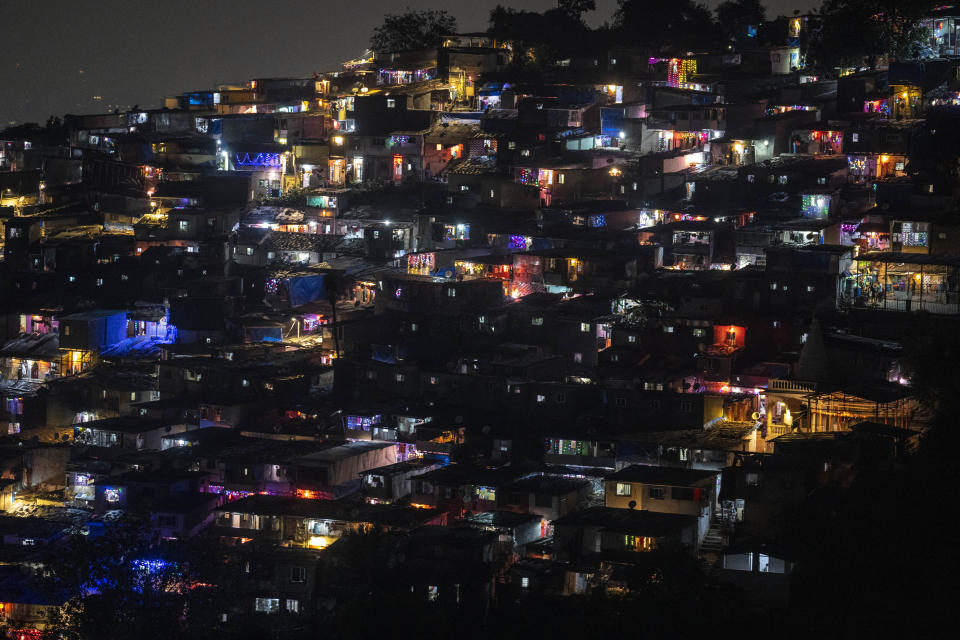
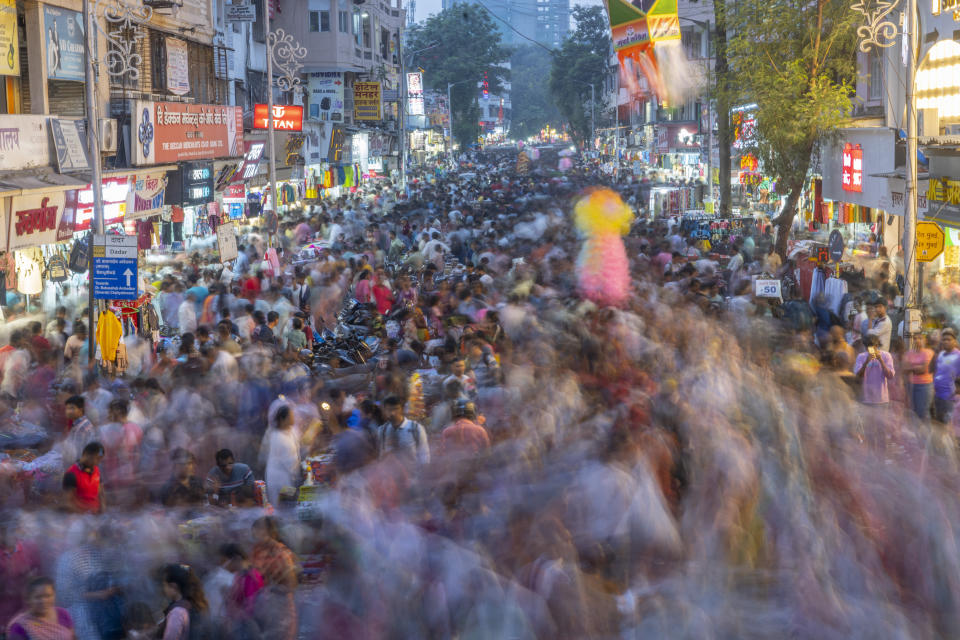
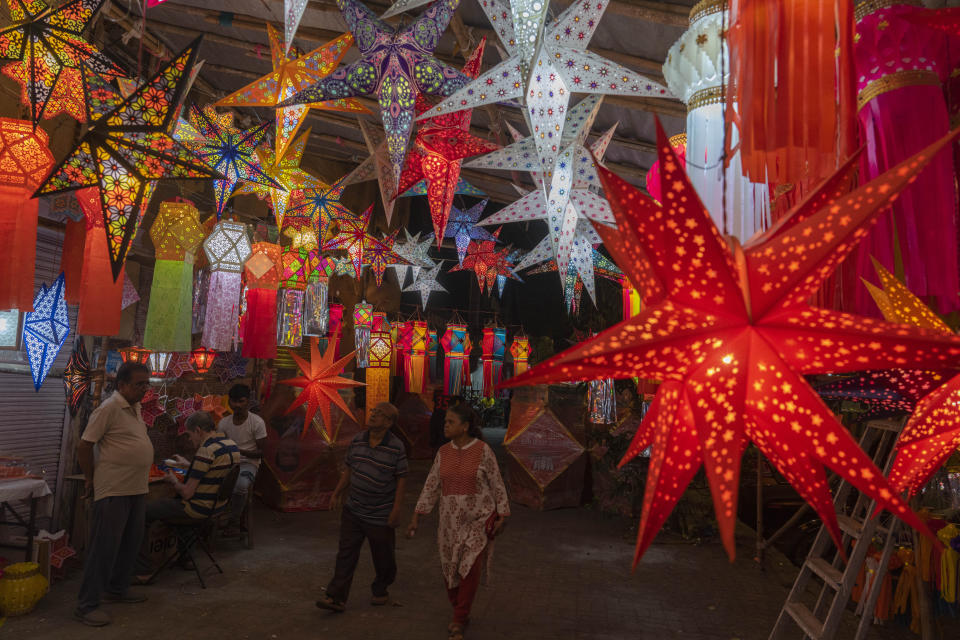
India Festival
People look at lanterns displayed for sale at roadside stalls ahead of Diwali festival in Mumbai, India, Sunday, Nov. 5, 2023.
Thu, November 9, 2023





India Festival
People look at lanterns displayed for sale at roadside stalls ahead of Diwali festival in Mumbai, India, Sunday, Nov. 5, 2023.
(AP Ph
Diwali is the most important festival of the year in India — and for Hindus in particular.
It is celebrated across faiths by more than a billion people in the world’s most populous nation and the diaspora. Over five days, people take part in festive gatherings, fireworks displays, feasts and prayer.
Diwali is derived from the word “Deepavali,” which means “a row of lights.” Celebrants light rows of traditional clay oil lamps outside their homes to symbolize the victory of light over darkness and knowledge over ignorance.
WHEN IS DIWALI?
The dates of the festival are based on the Hindu lunar calendar, typically falling in late October or early November.
This year, Diwali begins Nov. 10 and the festival will be observed on Nov. 12.
WHAT ARE SOME HINDU STORIES OF DIWALI?
While Diwali is a major religious festival for Hindus, it is also observed by Sikhs, Jains and Buddhists. The origin story of Diwali varies depending on the region. All these stories have one underlying theme — the victory of good over evil.
In southern India, Diwali celebrates the victory of Lord Krishna’s destruction of the demon Naraka who is said to have imprisoned women and tormented his subjects. In northern India, Diwali honors the triumphant return of Lord Rama, his wife Sita, and brother Lakshmana, from a 14-year exile in the forest.
HOW IS DIWALI CELEBRATED?
The festival brings with it a number of unique traditions, which also vary by the region. What all celebrations have in common are the lights, fireworks, feasting, new clothes and praying.
—In southern India, many have an early morning warm oil bath to symbolize bathing in the holy River Ganges as a form of physical and spiritual purification.
—In the north, worshipping the Goddess Lakshmi, who symbolizes wealth and prosperity, is the norm.
Gambling is a popular tradition because of the belief whoever gambled on Diwali night would prosper throughout the year. Many people buy gold on the first day of Diwali, known as Dhanteras — an act they believe will bring them good luck.
Setting off firecrackers is a cherished tradition, as is exchanging sweets and gifts among friends and family. Diwali celebrations typically feature rangoli, which are geometric, floral patterns drawn on the floor using colorful powders.
WHAT ARE THE DIWALI STORIES FROM OTHER FAITHS?
Buddhists, Jains and Sikhs have their own Diwali stories:
—Jains observe Diwali as the day the Lord Mahavira, the last of the great teachers, attained nirvana, which is liberation from the cycle of birth, death and rebirth.
—Sikhs celebrate Bandi Chhor Divas — a day that overlaps with Diwali — to commemorate the release of Guru Hargobind, a revered figure in the faith, who had been imprisoned for 12 years by the Mughal emperor Jahangir.
—Buddhists observe the day as one when the Hindu Emperor Ashoka, who ruled in the third century B.C., converted to Buddhism.
___
Associated Press religion coverage receives support through the AP’s collaboration with The Conversation US, with funding from Lilly Endowment Inc. The AP is solely responsible for this content.

Diwali is Sunday: Here's what to know about the Hindu holiday (and some tasty recipes)
It is celebrated across faiths by more than a billion people in the world’s most populous nation and the diaspora. Over five days, people take part in festive gatherings, fireworks displays, feasts and prayer.
Diwali is derived from the word “Deepavali,” which means “a row of lights.” Celebrants light rows of traditional clay oil lamps outside their homes to symbolize the victory of light over darkness and knowledge over ignorance.
WHEN IS DIWALI?
The dates of the festival are based on the Hindu lunar calendar, typically falling in late October or early November.
This year, Diwali begins Nov. 10 and the festival will be observed on Nov. 12.
WHAT ARE SOME HINDU STORIES OF DIWALI?
While Diwali is a major religious festival for Hindus, it is also observed by Sikhs, Jains and Buddhists. The origin story of Diwali varies depending on the region. All these stories have one underlying theme — the victory of good over evil.
In southern India, Diwali celebrates the victory of Lord Krishna’s destruction of the demon Naraka who is said to have imprisoned women and tormented his subjects. In northern India, Diwali honors the triumphant return of Lord Rama, his wife Sita, and brother Lakshmana, from a 14-year exile in the forest.
HOW IS DIWALI CELEBRATED?
The festival brings with it a number of unique traditions, which also vary by the region. What all celebrations have in common are the lights, fireworks, feasting, new clothes and praying.
—In southern India, many have an early morning warm oil bath to symbolize bathing in the holy River Ganges as a form of physical and spiritual purification.
—In the north, worshipping the Goddess Lakshmi, who symbolizes wealth and prosperity, is the norm.
Gambling is a popular tradition because of the belief whoever gambled on Diwali night would prosper throughout the year. Many people buy gold on the first day of Diwali, known as Dhanteras — an act they believe will bring them good luck.
Setting off firecrackers is a cherished tradition, as is exchanging sweets and gifts among friends and family. Diwali celebrations typically feature rangoli, which are geometric, floral patterns drawn on the floor using colorful powders.
WHAT ARE THE DIWALI STORIES FROM OTHER FAITHS?
Buddhists, Jains and Sikhs have their own Diwali stories:
—Jains observe Diwali as the day the Lord Mahavira, the last of the great teachers, attained nirvana, which is liberation from the cycle of birth, death and rebirth.
—Sikhs celebrate Bandi Chhor Divas — a day that overlaps with Diwali — to commemorate the release of Guru Hargobind, a revered figure in the faith, who had been imprisoned for 12 years by the Mughal emperor Jahangir.
—Buddhists observe the day as one when the Hindu Emperor Ashoka, who ruled in the third century B.C., converted to Buddhism.
___
Associated Press religion coverage receives support through the AP’s collaboration with The Conversation US, with funding from Lilly Endowment Inc. The AP is solely responsible for this content.

Diwali is Sunday: Here's what to know about the Hindu holiday (and some tasty recipes)
James Powel, USA TODAY
Updated Fri, November 10, 2023
Members of the South Asian community will be celebrating one of the important days on their religious calendar on Sunday.
Diwali, the five-day festival of lights, kicks off Friday and will include sweet treats and artistic combinations of flowers, powder, rice or sand called rangolis to bring good luck and fireworks.
The holiday, also called Deepavali which translates to "a row of lamps and lights," centers around clay pots that are placed around homes and places of worship that symbolize the light within man that can overcome the darkness of ignorance, according to the Hindu American Foundation.
The celebration is a public holiday in many parts of India and is recognized on the New York City school holiday calendar.
Here's what to know about Diwali.
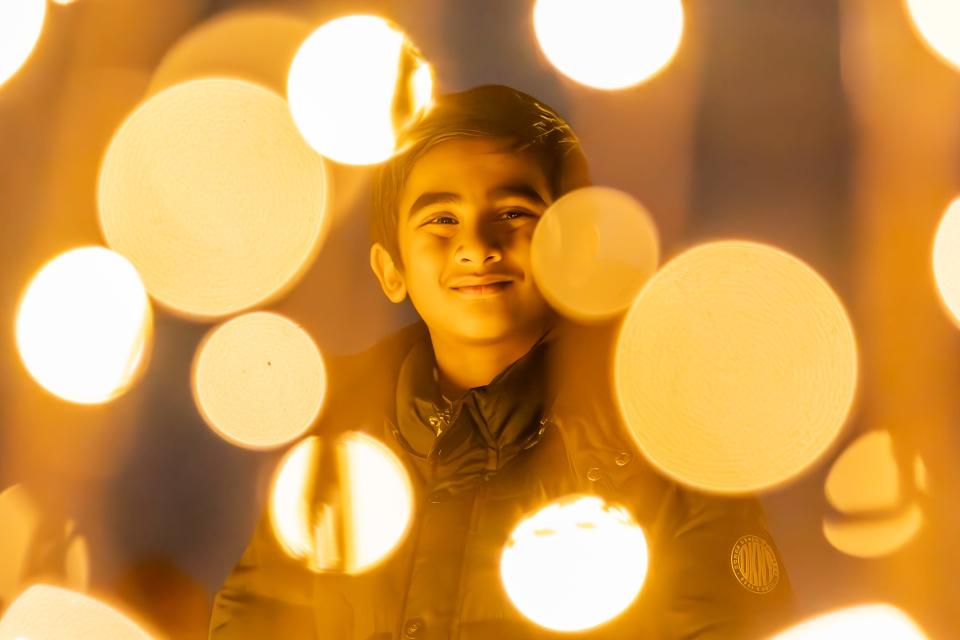
Thousands turned out at the Diwali celebration at Papaianni Park in Edison on Nov. 4, 2023.
Members of the South Asian community will be celebrating one of the important days on their religious calendar on Sunday.
Diwali, the five-day festival of lights, kicks off Friday and will include sweet treats and artistic combinations of flowers, powder, rice or sand called rangolis to bring good luck and fireworks.
The holiday, also called Deepavali which translates to "a row of lamps and lights," centers around clay pots that are placed around homes and places of worship that symbolize the light within man that can overcome the darkness of ignorance, according to the Hindu American Foundation.
The celebration is a public holiday in many parts of India and is recognized on the New York City school holiday calendar.
Here's what to know about Diwali.

Thousands turned out at the Diwali celebration at Papaianni Park in Edison on Nov. 4, 2023.
What does Diwali celebrate?
Many Hindus observe Diwali as a day of celebrating the return of Prince Rama of Ayodhya, his wife Sita, and brother Lakshman after 14 years of exile, according to the Hindu American Foundation. Some Hindus celebrate the holiday as the day Lord Krishna defeated the demon king Narakasura.
Diwali is also celebrated by Jains, Sikhs, and some Buddhists with each honoring different portions of their cultural histories.
The common thread between the cultural interpretations of the holiday is the victory of light over darkness.
When is Diwali?
This year Diwali begins November 10 and runs until November 15.
Report: As turkey prices drop, cost of some Thanksgiving side dishes go up
How is Diwali celebrated?
The festival is celebrated across five days with each day having particular rituals associated with them.
Day 1 Dhanteras: Celebrants clean their homes, make rangolis and kolam, a decorative art drawn with rice flour, and shop for and prepare food
Day 2 Chhoti Diwali, Kalichauda: Referred to as "small Diwali" celebrants decorate their homes and place clay pots
Day 3 Diwali: The height of the holiday, celebrants wear their best clothes, light lamps and have as much light as possible in their homes and watch fireworks
Day 4 Annakut, Padwa, Govardhan Puja: Considered by many celebrants as the first day of the new year, the day is one of thanksgiving and reflection
Day 5 Bhai Duj, Bhai Bheej: A day to celebrate brother-sister relationsips, siblings gather to honor their bond
What is eaten during Diwali?
The festival is known for its sweet snacks that are eaten throughout the five days. Commonly consumed treats include: motichur laddu a sugary concoction that melts in your mouth, jalebiis a spiral-shaped sweet made of all-purpose flour, gram flour and sugar syrup and gulab jamun is a dessert made of small balls (like the size of donut holes) dipped in a pool of rose-flavored sugar syrup.
Here are some recipes to consider if you are partaking in the festival this year:
Date and nut bar (khajoor tukda)
These bars are made from dates, cashews, almonds and pistachios without added sugar. They make great power bars. This recipe is from "Beyond the Curry with Bharti," by Bharti Sanghavi.
Makes: 15 pieces
Ingredients:
¼ cup raw almonds, cut in half widthwise
¼ cup raw cashew pieces
¼ cup raw pistachios
½ pound Medjool dates, fresh, pitted (about 13 dates)
½ teaspoon ghee, plus more for brushing (see note)
Instructions:
Mix all nuts, and dry roast in a medium pan over medium heat on the stovetop for four or five minutes, stirring occasionally so they toast evenly. Set aside.
In a small pan, saute dates for 2 minutes over medium heat. They will melt into a thick pulp.
Remove dates from heat, and add nuts. Mix well.
Brush a cutting board and rolling pan with ½ teaspoon ghee. Make a smooth ball from date and nut mixture and roll into a ½ inch thick square sheet on the cutting board.
Brush ghee on top of mixture. Let it cool for 15 to 20 minutes.
Cut into 1½ by 1½ inch squares.
Store in refrigerator. Serve at room temperature.
Note: Ghee is clarified butter that is sold at Indian markets and at many other grocers. It can be made at home by melting butter until the milk solids separate and come to rest on the bottom of the pan; pour off the clarified liquid butter, leaving the solids behind. Allow to cool and solidify.
Lentil crispies (chorafali)
Chorafali is a traditional Diwali festival snack. Originating from the Indian state of Gujarat, chorafali is highly anticipated on the Diwali table, since it’s usually made once a year. Chorafali are light and fluffy snacks that melt in your mouth. This recipe is a personal recipe from Bharti Sanghavi, who runs Indian Groceries & Spices in Wauwatosa, Wisconsin.
Makes: 10 cups
Ingredients:
½ cup water, plus 2 tablespoons
½ teaspoon salt
½ teaspoon baking soda or papad khar (alkaline salt)
3 teaspoons of any neutral oil, plus more for deep frying and oiling surface
2 cups gram flour (besan or chickpea flour)
1 cup urad (lentil) flour (see note)
1 teaspoon red chile powder
1 teaspoon black salt
Instructions:
In a small pot, bring ½ cup water, salt, baking soda and oil to a boil. Turn off heat.
In a large mixing bowl, combine flours. Little by little, add hot water mixture, mixing with a spoon. Add another 2 tablespoons of room-temperature water to make a firm dough.
Knead dough with a little oil on a flat surface. Let rest for 15 minutes.
Meanwhile, in a small bowl, combine the chile powder and black salt to garnish the finished chips later.
Halve the rested dough so kneading is easier. Knead one portion for a few minutes until the dough's color lightens.
Roll dough into a rope about 7 inches long and cut into even 7 equal pieces. Roll each piece with a rolling pin until it's 5 inches wide. Cut into ½-inch-wide strips.
Heat 1 to 2 inches of oil in a wok or heavy medium pot to 375 degrees. Place 2 or 3 strips into the oil and fry until golden brown on both sides. It will take a few seconds for them to puff up after adding them to the oil. Remove, using a slotted spoon, and drain on paper towel. Sprinkle a bit of red chile powder and black salt on top.
Repeat with remaining dough.
Serve at room temperature. Store in airtight jars for 3 to 4 weeks.
This article originally appeared on USA TODAY: When is Diwali 2023, what is the holiday and why is it celebrated?
Diwali 2023: The symbolic foods eaten during the Festival of Lights
Olivia Petter
Fri, November 10, 2023
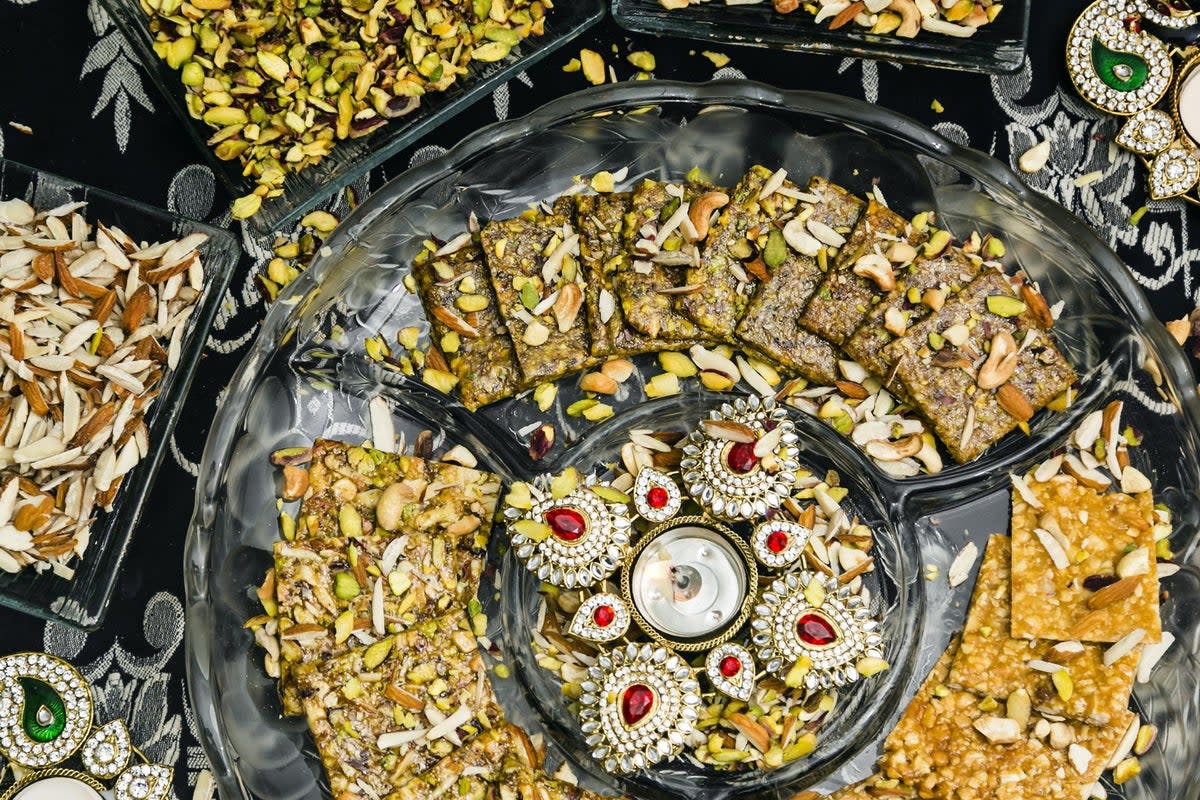
Diwali 2023: The symbolic foods eaten during the Festival of Lights
Diwali, the festival lights, sees millions of people attend events across the world every autumn to celebrate the triumph of good over evil.
Celebrated by Hindus, Sikhs and Jains, Diwali is one of the most significant festivals in Indian culture and calls for a number of traditional dishes.
From the popular sweet treats to the savoury main meals, here are some of the key foods eaten over the course of the five-day celebration, which this year begins on Sunday 12 November.
Mithai

(Getty Images/iStockphoto)
South Asian sweets and desserts are called mithai and are a staple part of Diwali celebrations.
Many of the treats are fried foods made from sugar, chickpea flour and condensed milk.
They vary between regions but common ones include balushahi, which are a bit like doughnuts, laddoos and barfis.
They can be eaten alongside savoury items or eaten alone as a snack.
It is custom to exchange decorated boxes of mithai among family and friends during Diwali.
Chivda
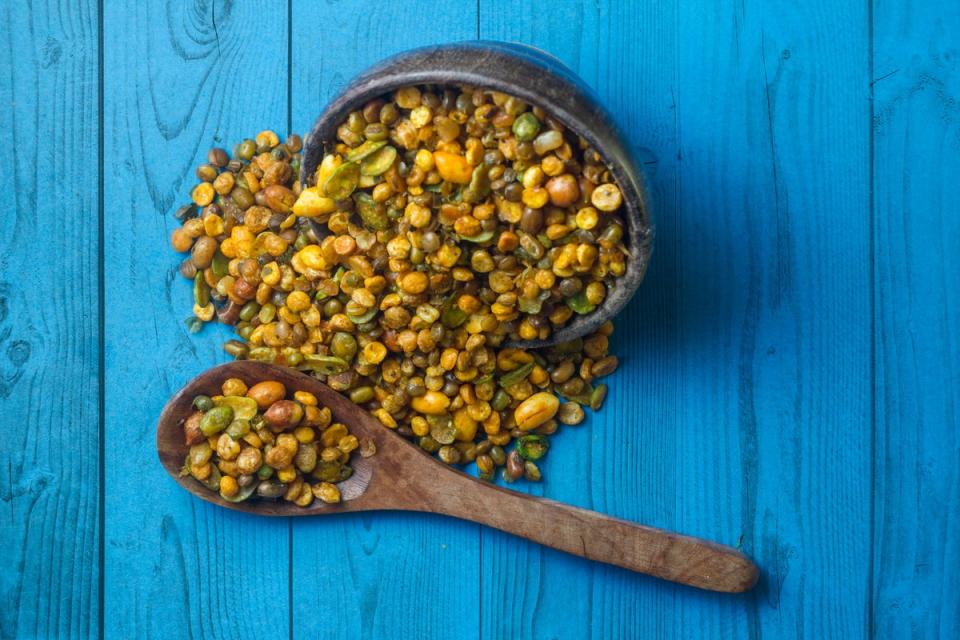
(Getty Images/iStockphoto)
Snacks are a fundamental part of the Diwali menu and many of them come in the form of chivda, a spiced Bombay mix that consists of a variety of dried ingredients, such as peanuts, chickpeas, fried onion and fried lentils.
Sometimes, it’s eaten as part of a meal but most of the time it’s enjoyed on its own as a snack.
The festival is known for its sweet snacks that are eaten throughout the five days. Commonly consumed treats include: motichur laddu a sugary concoction that melts in your mouth, jalebiis a spiral-shaped sweet made of all-purpose flour, gram flour and sugar syrup and gulab jamun is a dessert made of small balls (like the size of donut holes) dipped in a pool of rose-flavored sugar syrup.
Here are some recipes to consider if you are partaking in the festival this year:
Date and nut bar (khajoor tukda)
These bars are made from dates, cashews, almonds and pistachios without added sugar. They make great power bars. This recipe is from "Beyond the Curry with Bharti," by Bharti Sanghavi.
Makes: 15 pieces
Ingredients:
¼ cup raw almonds, cut in half widthwise
¼ cup raw cashew pieces
¼ cup raw pistachios
½ pound Medjool dates, fresh, pitted (about 13 dates)
½ teaspoon ghee, plus more for brushing (see note)
Instructions:
Mix all nuts, and dry roast in a medium pan over medium heat on the stovetop for four or five minutes, stirring occasionally so they toast evenly. Set aside.
In a small pan, saute dates for 2 minutes over medium heat. They will melt into a thick pulp.
Remove dates from heat, and add nuts. Mix well.
Brush a cutting board and rolling pan with ½ teaspoon ghee. Make a smooth ball from date and nut mixture and roll into a ½ inch thick square sheet on the cutting board.
Brush ghee on top of mixture. Let it cool for 15 to 20 minutes.
Cut into 1½ by 1½ inch squares.
Store in refrigerator. Serve at room temperature.
Note: Ghee is clarified butter that is sold at Indian markets and at many other grocers. It can be made at home by melting butter until the milk solids separate and come to rest on the bottom of the pan; pour off the clarified liquid butter, leaving the solids behind. Allow to cool and solidify.
Lentil crispies (chorafali)
Chorafali is a traditional Diwali festival snack. Originating from the Indian state of Gujarat, chorafali is highly anticipated on the Diwali table, since it’s usually made once a year. Chorafali are light and fluffy snacks that melt in your mouth. This recipe is a personal recipe from Bharti Sanghavi, who runs Indian Groceries & Spices in Wauwatosa, Wisconsin.
Makes: 10 cups
Ingredients:
½ cup water, plus 2 tablespoons
½ teaspoon salt
½ teaspoon baking soda or papad khar (alkaline salt)
3 teaspoons of any neutral oil, plus more for deep frying and oiling surface
2 cups gram flour (besan or chickpea flour)
1 cup urad (lentil) flour (see note)
1 teaspoon red chile powder
1 teaspoon black salt
Instructions:
In a small pot, bring ½ cup water, salt, baking soda and oil to a boil. Turn off heat.
In a large mixing bowl, combine flours. Little by little, add hot water mixture, mixing with a spoon. Add another 2 tablespoons of room-temperature water to make a firm dough.
Knead dough with a little oil on a flat surface. Let rest for 15 minutes.
Meanwhile, in a small bowl, combine the chile powder and black salt to garnish the finished chips later.
Halve the rested dough so kneading is easier. Knead one portion for a few minutes until the dough's color lightens.
Roll dough into a rope about 7 inches long and cut into even 7 equal pieces. Roll each piece with a rolling pin until it's 5 inches wide. Cut into ½-inch-wide strips.
Heat 1 to 2 inches of oil in a wok or heavy medium pot to 375 degrees. Place 2 or 3 strips into the oil and fry until golden brown on both sides. It will take a few seconds for them to puff up after adding them to the oil. Remove, using a slotted spoon, and drain on paper towel. Sprinkle a bit of red chile powder and black salt on top.
Repeat with remaining dough.
Serve at room temperature. Store in airtight jars for 3 to 4 weeks.
This article originally appeared on USA TODAY: When is Diwali 2023, what is the holiday and why is it celebrated?
Diwali 2023: The symbolic foods eaten during the Festival of Lights
Olivia Petter
Fri, November 10, 2023

Diwali 2023: The symbolic foods eaten during the Festival of Lights
Diwali, the festival lights, sees millions of people attend events across the world every autumn to celebrate the triumph of good over evil.
Celebrated by Hindus, Sikhs and Jains, Diwali is one of the most significant festivals in Indian culture and calls for a number of traditional dishes.
From the popular sweet treats to the savoury main meals, here are some of the key foods eaten over the course of the five-day celebration, which this year begins on Sunday 12 November.
Mithai

(Getty Images/iStockphoto)
South Asian sweets and desserts are called mithai and are a staple part of Diwali celebrations.
Many of the treats are fried foods made from sugar, chickpea flour and condensed milk.
They vary between regions but common ones include balushahi, which are a bit like doughnuts, laddoos and barfis.
They can be eaten alongside savoury items or eaten alone as a snack.
It is custom to exchange decorated boxes of mithai among family and friends during Diwali.
Chivda

(Getty Images/iStockphoto)
Snacks are a fundamental part of the Diwali menu and many of them come in the form of chivda, a spiced Bombay mix that consists of a variety of dried ingredients, such as peanuts, chickpeas, fried onion and fried lentils.
Sometimes, it’s eaten as part of a meal but most of the time it’s enjoyed on its own as a snack.
Lapsi Halwa
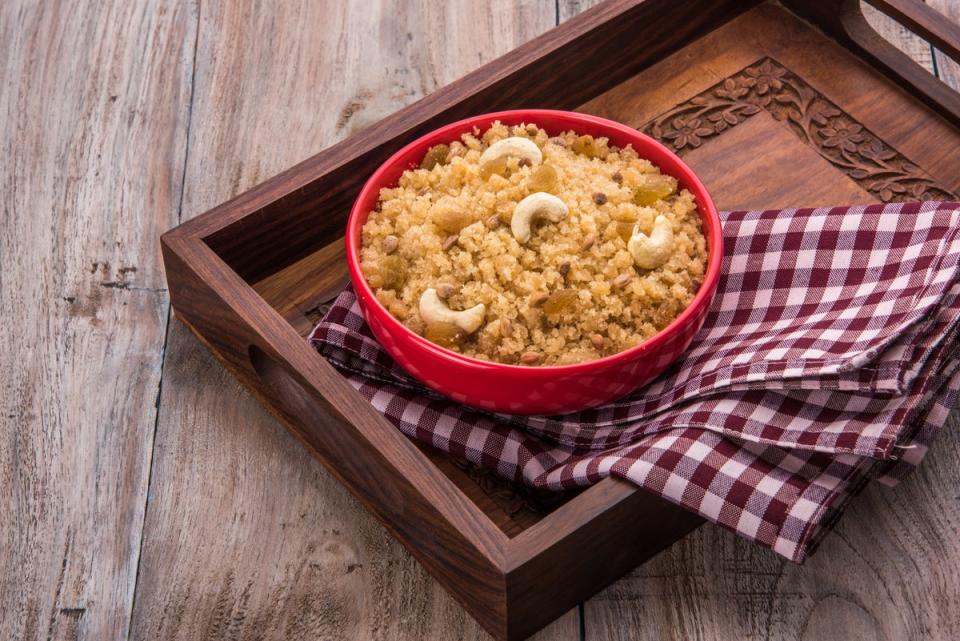
(Getty Images/iStockphoto)
This sweet dish is often eaten on the very first day of Diwali and is made from large-grain cracked wheat, which is then cooked with ghee and sweetened with sugar and cardamom powder.
It’s incredibly popular and is often served with a yardlong bean curry, as the beans are thought to represent longevity.
Aloo Tikki

(Getty Images/iStockphoto)
These small, fried patties are made from shredded potatoes and are usually served alongside regional sauces, such as mint sauce or tamarind sauce.
They look and taste a bit like potato pancakes and are usually crispy on the outside and soft on the inside, making them an irresistible traditional Indian delicacy.
Samosas

(Getty Images/iStockphoto)
Though they’re eaten all year round, samosas peak in popularity around Diwali.
The fried pockets of pastry usually come in the shape of a triangle and are stuffed with either mince meat, lentils or vegetables.
Because Diwali is all about celebrating the sweetness of life, special sweet versions are often made to mark the festival, containing ingredients such as coconut, cardamom and of course, sugar.
Why Diwali Remains My Most Treasured Holiday of the Year
Manali Jobanputra
Thu, November 9, 2023
From delicious foods to decorations and gift-giving, the annual Hindu festival of lights celebrated in late fall is a full-on family affair.
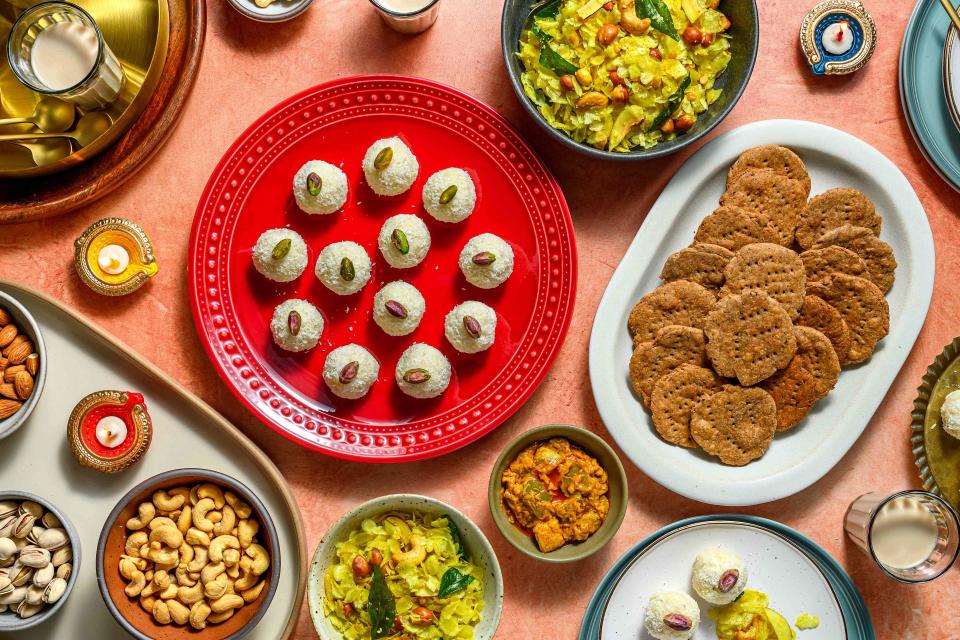
The Spruce Eats / Bahareh Niati
As the air turns crisp, and the city comes alive with shimmering lights, my heart fills with bubbling excitement and anticipation because Diwali is just around the corner.
It’s the time when Maa turns us into Monica Geller and we embark on a mission to clean every nook and cranny of the house, which is the prime step in preparing for Diwali. We spend at least three weeks meticulously scrubbing, swabbing, and washing everything until it’s Monica clean.
Besides cleaning, another prerequisite and my favorite pre-Diwali tradition is preparing faral, the snacks and sweets for the holiday. There are umpteen varieties and these treats vary based on region, tradition, and family preferences. Our family favorites are mathri (a flaky biscuit), chakli (a spiky spiral of fried dough), chiwda (a fried snack mix), and coconut ladoo (round sweet treats). Among these, coconut laddoos hold an extremely special place in my heart. They are the essence of my Diwali.
My Love of Coconut Ladoos
As a child, I couldn’t yet partake in preparing faral so I spent my time sitting around the kitchen adoring Maa. I yearned for the day I would be able to join in. To include me, Maa came up with a little ritual.
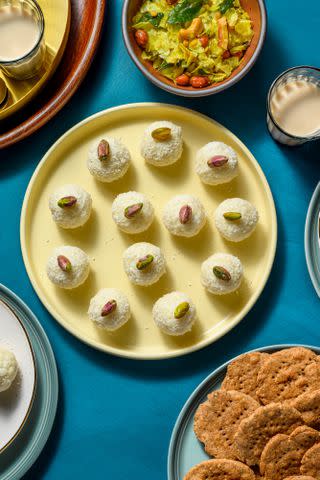
The Spruce Eats / Bahareh Niati
When making coconut ladoos; she would prepare the ladoo mix, and include us to help roll and shape them. We sat on the patio, rolling ladoos and sharing laughs. My brother and I couldn't resist gobbling up a couple, which led to Maa's playful scolding since we ate them before offering bhog (food offered to god). What started as a little ritual to make me feel included has now become a cherished tradition in our family. To this day, we make ladoos together.
By the way, my brother and I are still sneaking ladoos, and Maa has finally given up on scolding us! The aroma of coconuts, our family gathered around, sharing laughter and stories while shaping ladoos is a priceless memory that always warms my heart.
Preparing for Diwali as a Family
Now that I am grown up, both Maa and I prepare the faral. Mathri is an essential companion to our evening chai, without which no chai-time is truly complete. Chiwda, a cherished childhood tiffin snack, is yet another perfect chai-time companion. Mohanthal is the melt-in-the-mouth sweet that we savor between meals (or any opportunity we get). And there are so many more dishes.
In addition to our homemade delights, we also buy ready-made sweet boxes–gifting these during Diwali is a customary practice. These sweet boxes feature an array of other tantalizing treats such as kaju katli and badam katli (fudge-like sweets made with cashews and almonds, respectively), soan papdi (a flaky sweet), motichoor laddoo (another kind of sweet ball), and more delights that we don’t usually prepare at home.
Apart from food, decoration such as lanterns, lights, rangolis (temporary floor designs using a mix of materials), diyas (candles), and torans (decorative door hangings), are all an integral part of Diwali. My brother and I take great joy in adorning the house every year, and the glimmer of colorful lights and decor at dusk creates a truly breathtaking sight.
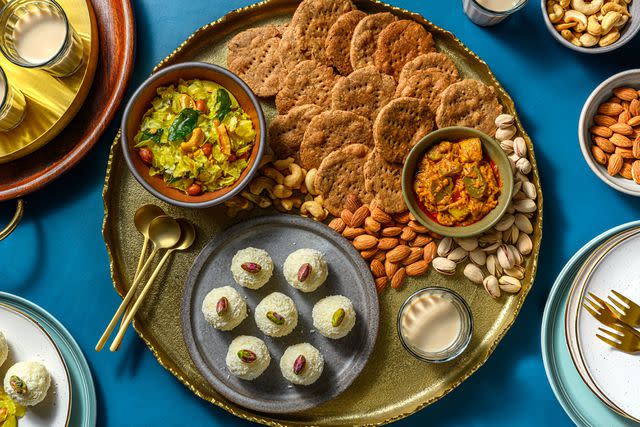
The Spruce Eats / Bahareh Niati
Diwali Gifts and More Beautiful Traditions
Another enjoyable tradition is shopping, encompassing everything from clothing and crackers to jewelry and even real estate. As Diwali marks the most auspicious time of the year, people often make substantial investments, including purchasing homes, cars, and gold. Our family has a cherished tradition of buying gold, and my dad delights both Maa and me with beautiful gold jewelry. This custom has now extended to my husband, who also surprises me with some exquisite jewelry.
A vital aspect of our celebration involves acts of kindness, especially towards the unsung heroes–our community helpers. Through sweets and gifts, we express our heartfelt gratitude to them. Celebrating with them not only heightens our own joy but also enriches the festive spirit with a profound sense of purpose and significance.

The Spruce Eats / Bahareh Niati
Diwali is that special time of the year when we willingly wake up at 4 AM, without an alarm or Mom's reverberating wake-up call. Mornings begin with bursting crackers and are followed by pooja (a Hindi word that means prayer and worship). Each of the five days of Diwali marks a different occasion hence a different pooja. We pray and offer gratitude for our family, home, and other precious belongings. Following the pooja, as we seek blessings from our elders, we are graciously gifted with naik, a monetary blessing. My brother loves this tradition as he is the youngest, so we all shower him with cash and he feels like he is the next Bezos.
The evening festivities are adorned with the warm glow of diyas, family reunions, faral, and of course crackers. The day after Diwali marks the beginning of the new year as per the Hindu calendar, and we welcome it surrounded by our loved ones with immense joy, fun, and blessings.
If this has sparked your excitement too and you're eager to partake in Diwali celebrations, I've included recipes for some of these mouthwatering dishes below. Give them a whirl and fully embrace the delightful spirit of our Desi festivities.
Get the Recipes
Mathri
Coconut Laddoo
Chivda
Wishing you a very happy Diwali and prosperous new year!
Read the original article on The Spruce Eats.
SEE


No comments:
Post a Comment